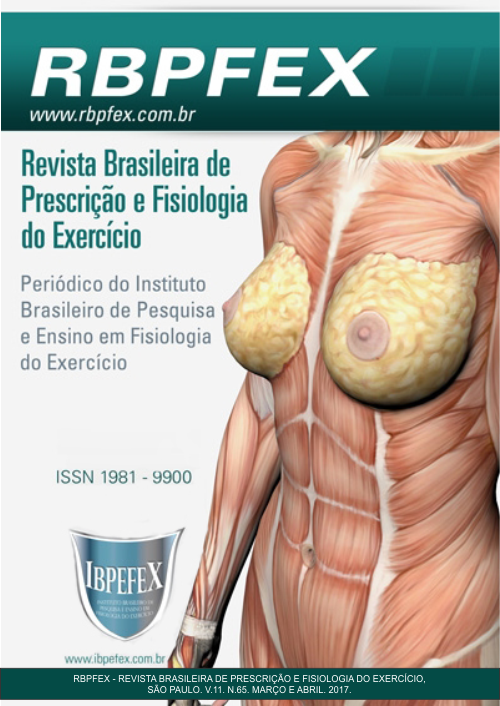Hand grip sretngth using dynamometer in hemiparetic individuals after stroke
Abstract
Aim: to determine the grip strength by dynamometry in hemiparetic individuals post stroke. Materials and Methods: Grip strength was analyzed in 18 individuals (7 women and 11 men) using a dynamometer (Din Standard®, Cefise®) and body mass with an electronic scale (Camry®). Data was presented in mean and standard deviation. Grubbs, Kolmogorov-Smirnov, and Student's T tests were used, with a 95% confidence interval and p ≤ 0.05. Data were analyzed in GraphPad Prism® 5. Results: Significant difference was found between paretic extremity and non-paretic extremity (p < 0.0001). Significant differences was found in paretic extremities between men and women (p < 0.05); No significant difference was found in male's paretic extremities (p = 0.4633); Significant differences was also found in male's paretic and non-paretic upper extremities (p < 0.0001); and when compared the female's paretic and non-paretic upper extremities (p < 0.05). Conclusion: Hemiparetic individuals have reduced strength in affected side, when compared with his non-paretic sides; Moreover, no differences were found between male and females regarding paretic upper extremities.
References
-Adams, H. P.; e colaboradores. Guidelines for the Early Management of Adults With Ischemic Stroke A Guideline From the American Heart Association/American Stroke Association Stroke Council, Clinical Cardiology Council, Cardiovascular Radiology and Intervention Council, and the Atherosclerotic Peripheral Vascular Disease and Quality of Care Outcomes in Research Interdisciplinary Working Groups: The American Academy of Neurology affirms the value of this guideline as an educational tool for neurologists. Circulation. Vol. 115. Núm. 20. p. e478-e534. 2007.
-Andrews, A. W.; Bohannon, R. W. Distribution of muscle strength impairments following stroke. Clinical Rehabilitation. Vol. 14. Núm. 1. p. 79-87. 2000.
-Aquino, C.; e colaboradores. A utilização da dinamometria isocinética nas ciências do esporte e reabilitação. Rev. bras. ciênc. mov, Vol. 15. Núm. 1. p. 93-100. 2007.
-Boissy, P.; e colaboradores. Maximal grip force in chronic stroke subjects and its relationship to global upper extremity function. Clinical rehabilitation. Vol. 13. Núm. 4. p. 354-362, 1999.
-Haaland, K. Y.; Delaney, H. D. Motor deficits after left or right hemisphere damage due to stroke or tumor. Neuropsychologia. Vol. 19. Núm. 1. p. 17-27. 1981.
-Lucena, E. M. D. F.; e colaboradores. A funcionalidade de usuários acometidos por AVE em conformidade com a acessibilidade à reabilitação. Acta fisiátrica. Vol. 18. Núm. 3, 2011.
-Miller, A. E. J.; e colaboradores Gender differences in strength and muscle fiber characteristics. European journal of applied physiology and occupational physiology. Vol. 66. Núm. 3. p. 254-262. 1993.
-Norman, K.; e colaboradores. The Subjective Global Assessment reliably identifies malnutrition-related muscle dysfunction. Clinical nutrition. Vol. 24. Núm. 1. p. 143-150. 2005.
-O'Sullivan, S. B.; Schmitz, T. J. Acidente Vascular Encefálico. In: (Ed.). Fisioterapia -Avaliação e Tratamento. 2003.
-Paz, L. P. D. S.; Marães, V. R. F. D. S.; Borges, G. Relação entre a força de preensão palmar e a espasticidade em pacientes hemiparéticos após acidente vascular cerebral. Acta fisiátrica. Vol. 18. Núm. 2. 2011.
-Polese, J. C. Parâmetros Biomecânicos e Percepção de Hemiparéticos Crônicos com o uso de Dispositivos Auxiliares na Marcha. 2011. Dissertação de Mestrado. UFMG. 2010. 135p
-Saliba, V. A.; e colaboradores. Propriedades psicométricas da Motor Activity Log: uma revisão sistemática da literatura. Fisioter Mov. Vol. 21. Núm. 3. p. 59-67. 2008.
-Sasaki, H.; e colaboradores. Grip strength predicts cause-specific mortality in middle-aged and elderly persons. The American journal of medicine. Vol. 120. Núm. 4. p. 337-342. 2007.
-Schlüssel, M. M.; Anjos, L. A. D.; Kac, G. A dinamometria manual e seu uso na avaliação nutricional:[revisão]. Rev. nutr. Vol. 21. Núm. 2. p. 233-235. 2008.
-Teixeira-Salmela, L. F.; e colaboradores. Musculação e condicionamento aeróbico na performance funcional de hemiplégicos crônicos. Acta fisiátrica. Vol. 10. Núm. 2. p. 54-60. 2003.
Authors who publish in this journal agree to the following terms:
- Authors retain the copyright and grant the journal the right of first publication, with work simultaneously licensed under the Creative Commons Attribution License BY-NC which allows the sharing of the work with acknowledgment of the authorship of the work and initial publication in this journal.
- Authors are authorized to enter into additional contracts separately for non-exclusive distribution of the version of the work published in this journal (eg, publishing in institutional repository or book chapter), with acknowledgment of authorship and initial publication in this journal.
- Authors are allowed and encouraged to post and distribute their work online (eg, in institutional repositories or on their personal page) at any point before or during the editorial process, as this can bring about productive change as well as increase impact and impact. citation of published work (See The Effect of Free Access).






